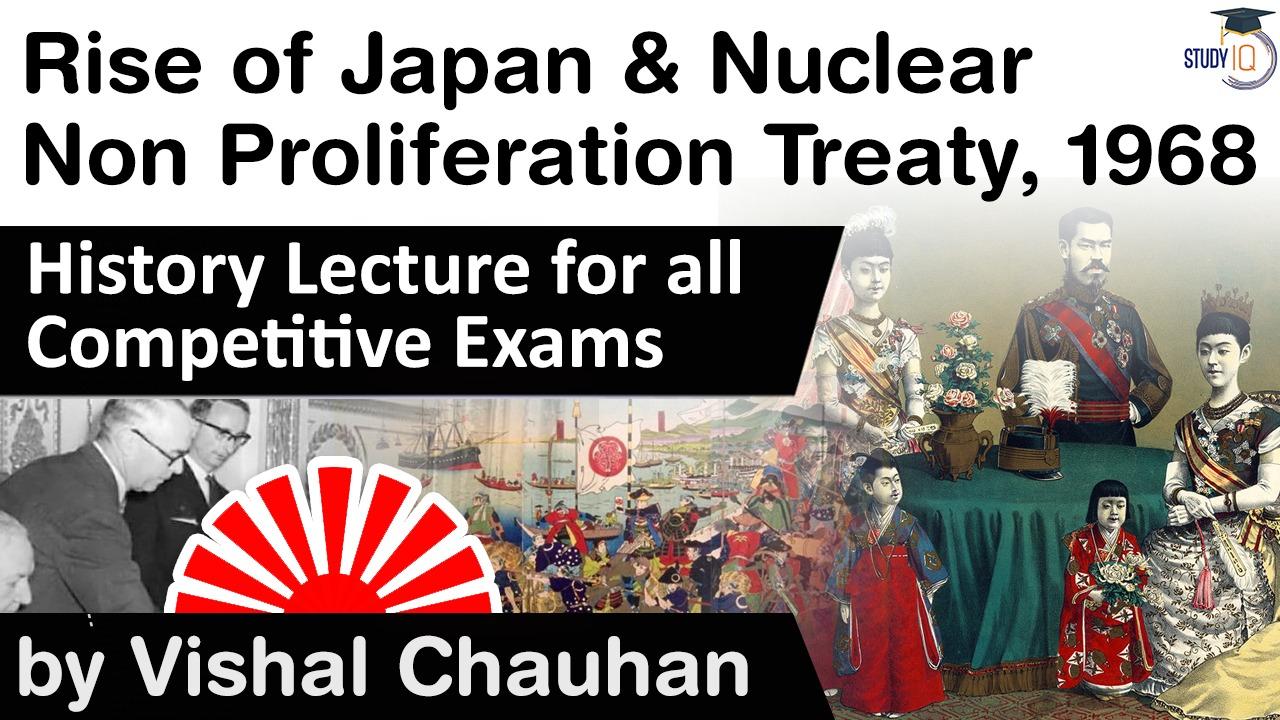Table of Contents
Rise of Japan as an Economic Superpower:
- After Japan’s unconditional surrender to the allied powers in August 1945, The United States military occupied the defeated nation and began a series of far-reaching reforms for the reconstruction of the country by reducing the power of the military and breaking up the largest Japanese business conglomerates(Zaibatsu).
- However, growing concern over communist power in East Asia, particularly the success of Chinese Communist party in its struggle against Chiang Kai-shek’s nationalist forces, led the United States to increasingly focus on the economic recovery and political rehabilitation of Japan.
- In this “Reverse Course,” Supreme Commander of the allied powers, general Douglas MacArthur, focused on strengthening, not punishing, what would became a key Cold War ally.
- After repulsing the communists from South Korea, The US started working toward making Japan a prosperous Cold War ally.
- Negotiated primarily by John foster Dulles in 1950 and 1951, the Treaty of San Francisco ended the state of war between Japan and 47 of the Allies( most nations allied with the Soviet Union refused to sign), concluded the American occupation, and excused the Japanese from reparations for the war.
- Acheson signed the San Francisco treaty on September 8, 1951, the same day he and Japanese Prime Minister Yoshida Shigeru signed the United States-Japan security treaty.
- The treaty allowed the United States to station troops in Japan, and made the Japanese islands into an important facet of America’s global containment structure.
- Following this development, investments of technology and capital flowed into Japan from America.
- There on, the Japanese economy gradually improved, so much so that the Japanese economy overtook the western European countries and became the second largest economy in the world for the most part of the latter part of the 20th century.
- It had retained this distinction and only recently has been surpassed by the Chinese economy, but still remains third largest economy in the world.
- To American leaders, Japan has transformed from World War Two enemy to vital ally, and Korea went from a peripheral region to a key battleground in the Cold War.
Nuclear Non-Proliferation Treaty, 1968:
- The lessons which the two superpowers learned from the Cuban missile crisis was a realization of the nature and extent of the dangers which the world might confront in the event of a full scale thermonuclear war.
- As a part of this realization, an urgent need to curtail the size of thermonuclear stockpile and to move forward towards overall disarmament.
- The NPT, an international treaty designed in 1968 was a major turning point in this direction.
- The nuclear Non-Proliferation treaty was an agreement signed in 1968 by several of the major Nuclear and non-Nuclear powers that pledged their cooperation in stemming the spread of nuclear technology.
- By 1964 there were five nuclear powers in the world: in addition to United States, The Soviet Union, and the United Kingdom, all of which obtain nuclear capability during or shortly after the Second World war, France exploded its first nuclear bomb in 1960, and the People’s Republic of China was not far behind in 1964.
- There were many other countries that had not yet tested weapons, but which were technologically advanced enough that should they decide to build them, it was likely that they could do so before long.


Background of the NPT:
- The spread of nuclear weapons technology meant several things for international law makers.
- While only countries that were capable of nuclear strike were the United States, it’s close ally Britain, and the Soviet Union, the doctrine of deterrence could be reasonably maintained.
- Because both sides of the Cold War had vast stocks of weapons and the capability of striking back after being attacked, any strike would likely have led to mutually assured destruction, and thus there remained a strong incentive for any power to avoid starting a nuclear war.
- However, if more nations, particularly developing nations that lay on the periphery of the balance of power between the two Cold War superpowers, achieve nuclear capability, this balance risk being disrupted and the system of deterrence would be threatened.
- Moreover, if countries with volatile border disputes became capable of attacking with nuclear weapons, then the odds of a nuclear war with truly global repercussions increased.
- This also caused the nuclear states to hesitate in sharing nuclear technology with developing nations, even technology that could be used for peaceful applications.
- All of these concerns led to international interests in a Nuclear Non-Proliferation treaty.
- Issues of Contention:
- Although the benefits to be derived from such a treaty were clear, its development was not without controversy.
- Initially, by 1965 the US negotiators worked to strike a delicate balance between the interests in preventing further transfer of the technology that it shared with the Soviet Union and the desire to strengthen its NATO allies by giving several western European nations some measures to control over nuclear weapons.
- This strategy of the US alarm the other members and threats to abandon the negotiations started pouring in and finally the US abandoned the plan in favor of reaching a workable treaty.
- A more difficult problem involved the question of bringing Non-Nuclear nations into line with planned treaty.
- Nations that had not yet developed nuclear weapons technology were essentially being asked to give up all intentions to ever develop the weapons.
- Without this agreement on the part of the Non-Nuclear powers, any real limitation on the number of worldwide nuclear powers was not possible.
- After two years of negotiations, the Nuclear powers managed to make enough concessions to include many Non-Nuclear powers to sign.
The Final treaty:
- The final treaty involved a number of provisions all aimed at limiting the spread of nuclear weapon technology.
- The Nuclear signatories agreed not to transfer either Nuclear Weapons or Nuclear Weapons technology to any other state.
- The Non-Nuclear states agreed that they would not receive, develop or otherwise acquired nuclear weapons.
- All of the signatories agreed to submit to the safeguards proliferation established by the International Atomic Energy agency( IAEA).
- Parties to the treaty also agreed to cooperate in the development of peaceful nuclear technology and to continue negotiations to help end the nuclear arms race and limit the spread of the technology.
- The treaty was given a 25 year time limit, with the agreement that it would be reviewed every five years.
- The nuclear Non-Proliferation treaty was, and continues to be, heralded as an important step in the ongoing efforts to reduce or prevent the spread of nuclear weapons.
- Still, it had one major drawback in that the two nuclear powers, France and the People’s Republic of China, did not sign the agreement, nor did a number of Non-Nuclear states.
- Of the Non-Nuclear states refusing to adhere, and thereby limit their own future nuclear programs, of particularly important were Argentina, Brazil, India, Israel, Pakistan and Saudi Arabia and South Africa, because these powers were close to being capable of the technology.
- In fact, in 1974, India joined the “nuclear club” by exploding its first weapon.
- Pakistan tested its first atomic bomb in 1983.






















 WhatsApp
WhatsApp